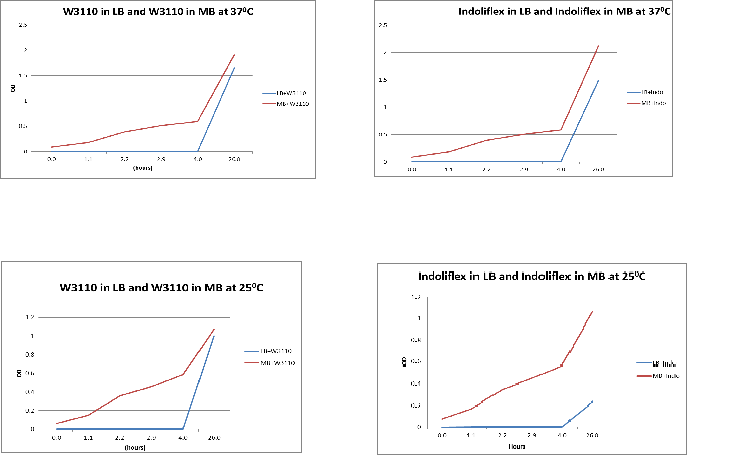Team:University College London/LabBook/Week13
From 2012.igem.org



Contents |
13-1
1.EXP 13.1 (Repetition of Nuclease Experiment) Monday 03/09
Aim: To repeat the DNAse/Nuclease Halo experiment in order to check whether results are repeatable. This included collecting data of halo diameters and colony diameters over 28 hour, and to determine how the nuclease production increases overtime.
Methods: For Wnu cell line which has native secreted nuclease activity 1. Prepare 11-16 plates (10ml LBAgar+10ul AMP +10 ul 1M IPTG). IPTG induces the lac promoter which in turn activates the transcription of nuclease. 2. Streak cells onto all plates at the same time 3. Incubate at 37°C 4. Apply hydrochloric acid (HCL) to the first plate before putting them in the incubator (set time as zero) 5. Take a second reading after four hours, followed by six readings every 3 hours, and a final three readings every two hours. 6. When the reading is taken, observe the following: a) Diameter of the colony (once the diameter of the colony is measured, pick the colony and put it to grow in LB for nine hours) b) Diameter of the halo that is achieved once HCL is applied c) OD from a) d) Estimate of the depth of the colony on the agar plate For BL21 cell line that has been modified to contain nuclease 7. Prepare 11-16 plates (LB Agar + CMP) 8. Streak cells onto all plates at the same time 9. Incubate at 37°C 10. Apply HCL to the first plate before putting in the incubator (set time as zero) 11. Take a second reading after four hours, followed by six readings every 3 hours, and a final three readings every two hours. 12. When the reading is taken, observe the following: a. Diameter of the colony (once the diameter of the colony is measured, pick the colony and put it to grow in LB for nine hours) b. Diameter of the halo that is achieved once HCL is applied c. OD from a) d. Estimate of the depth of the colony on the agar plate
Results: The following table images show the results of the DNase assay:
Plate Number Before HCL After HCL
2
3
4
5
6
7
8
9
10
11
The following table shows the colony and halo diameters, plus the OD of one plate at different sampling times.
Date Time Colony diameter Halo diameter Absorbance at OD600 03.09.2012 12.30pm 0 0 0 03.09.2012 16.30pm 0 0 0 03.09.2012 19.30 pm 0 0 0 03.09.2012 22.30 pm 0.5mm 1mm 0.002 04.09.2012 01.30 am 1mm 3.5mm 0.182 04.09.2012 04.30 am 1.5mm 7mm 0.238 04.09.2012 07.30 am 2mm 9mm 0.297 04.09.2012 10.30am 2.5mm 11mm 0.518 04.09.2012 12.30pm 3mm 12.5mm 0.701 04.09.2012 14.30pm 3.5mm 14mm 0.811 04.09.2012 16.30pm 4mm 15mm 0.906
Conclusion: We have obtained data consistent with the previous DNase assay conducted, and thereby conclude that a linear correlation exists between colony size and halo diameter.

Tuesday 04/09
Aim:
To pick colonies from all the ligation transformation plates, prepared in Week 12. This included the ligations of curli, laccase and nuclease to the linker and the pb. This was done in order to purify the DNA and use it in subsequent ligations. This was done because gels from Week 12 showed unexpected bands. Hence, it was necessary to check whether this was due to unsuccessful purification and analytical digest, or due to unsuccessful ligation.
Methods:
Wednesday 05/09
Aim:
To carry out a miniprep of the inoculations from the ligation transformation plates.
Method:
Results:
Gel not shown

Wednesday 05/09
Aim:
To characterise the two strains of laccase obtained from the laccase ligation.
Method:
1) W3110 cells transformed with laccase and control W3110 cells are inoculated in 10mL of LB media, and incubated overnight at 37˚C in a 200rpm shaker
2) The O/N culture is then centrifuged at 6100g for 20 minutes, in order to extract the media containing laccase. The supernatant is retained.
3) In order to take readings, cuvettes are prepared with 2.2mL KH2PO4 buffer + 0.5mL Laccase supernatant + 0.3mL Syringaldazine, which is added immediately before readings are begun (as explained in step 4). A blank is created using 0.5mL of LB media instead of laccase supernatant.
4) The optical density at 530nm of each of the samples is measured at five minute intervals over 30 minutes.
Conclusion:
We have determined that laccase strain 2 is a better laccase producing strain. Furthermore, we have proven the function of our BioBrick, as the oxidation activity of both laccase stratins was significantly higher than that of the control W3110 strain.

Thursday 06/09
Aim:
To compare the difference in growth of Indoli and E. coli growth in LB & MB media
Methods:
1. Inoculate 10ul of W3110 glycerol stock in 10ml of LB and another 10ul of W3110 glycerol stock in 10ml of MB
2. Repeat this with an indolifex glycerol stock
3. Measure the absorbence of all four samples every hour for 12 hours. Then take a final measurement after another 12 hours. Thus, measurements span 24 hours.
Results:
The following graphs show growth of the different strains and different media. The flasks were placed in a 370C shaker at 200rpm.
Conclusion:
From the above graphs, it can be seen that marine bacteria grows better in MB, irrespective of the temperature used.
 "
"
